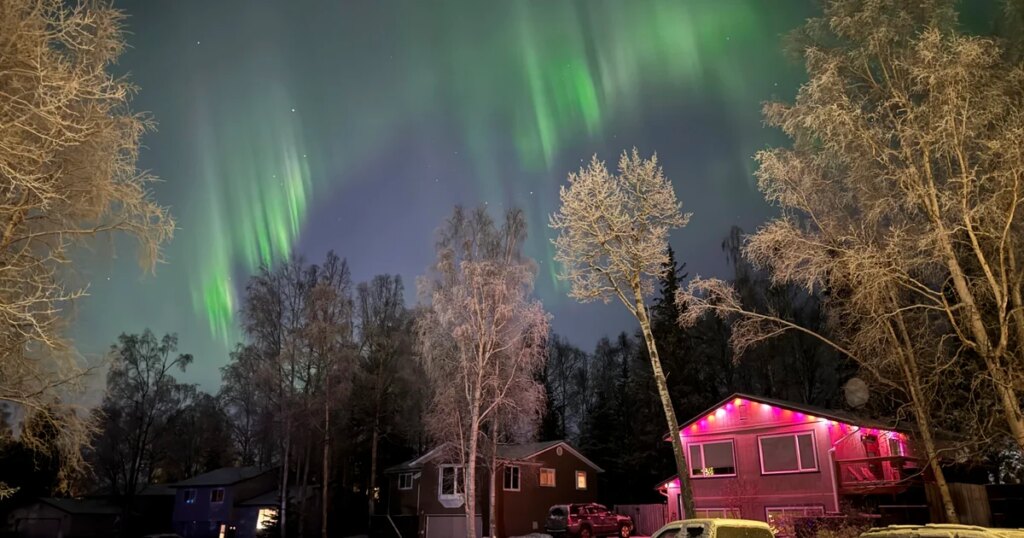A severe geomagnetic storm is anticipated to affect Earth on Wednesday, potentially disrupting technological infrastructure and enhancing visibility of the northern lights across much of the northern United States. This storm, classified as G4, is prompted by recent coronal mass ejections (CMEs) from the sun. According to officials from the National Oceanic and Atmospheric Administration (NOAA), the latest CME was the fastest and most energetic observed lately, linked to a powerful solar flare.
| Article Subheadings |
|---|
| 1) Understanding Geomagnetic Storms and Their Impact |
| 2) The Role of Coronal Mass Ejections |
| 3) Anticipated Timeline and Locations for Aurora Viewing |
| 4) Historical Context of Recent Geomagnetic Events |
| 5) Preparation for Potential Disruptions |
Understanding Geomagnetic Storms and Their Impact
Geomagnetic storms are disturbances in Earth’s magnetic field, primarily caused by solar activities like solar flares and coronal mass ejections. The intensity of these storms is measured on a scale from G1 to G5, with G5 being the most severe. The impending G4 storm could lead to significant disruptions in technology infrastructure, including GPS navigation, cell phone signals, and power grids. Such storms can also enhance the visibility of the aurora borealis, commonly known as the northern lights, which may extend further south than typical visibility regions.
The Role of Coronal Mass Ejections
Coronal mass ejections (CMEs) are large expulsions of plasma and magnetic field from the sun’s corona. These ejections can travel millions of miles per hour, impacting magnetospheres of planets like Earth. The NOAA reported that the recent CME was “the most energetic and fastest” among the recent events. This CME was also associated with one of the strongest solar flares recorded in the current solar cycle. The flare, which peaked early Tuesday morning, was classified as R3, indicating its potency and potential to disrupt radio communications on the sunlit side of Earth.
Anticipated Timeline and Locations for Aurora Viewing
The geomagnetic storm is expected to impact Earth around midday on Wednesday, though NOAA noted that the forecast timing carries a moderate level of uncertainty. However, particularly active auroral displays are likely to begin Tuesday night, as early as 10 p.m. ET, and may continue until approximately 1 a.m. Wednesday. Geographic locations such as Portland, Oregon; Cheyenne, Wyoming; and New York City are anticipated to witness these displays, while the aurora could be visible as far south as Oklahoma City and Raleigh, North Carolina.
Historical Context of Recent Geomagnetic Events
In May 2024, a CME resulted in the strongest geomagnetic storm in over two decades, marking a significant event in the history of solar activity. This storm resulted in multiple X-class solar flares and several reported disruptions in radio communications. Similarly, another notable geomagnetic storm occurred in October 2024, which enabled auroral visibility as far south as Florida. These prior instances showcase how solar activity can profoundly impact Earth on both a technological and aesthetic level.
Preparation for Potential Disruptions
As the predicted geomagnetic storm approaches, authorities, particularly the NOAA, advise preparation for potential disruptions. High-frequency radio communications on the sunlit side of Earth may experience major disturbances. Additionally, sectors relying on GPS and other navigational aids should remain cautious, particularly those in aviation and maritime operations. Utility companies should also be alert, as geomagnetic storms can strain power systems, potentially leading to outages in worst-case scenarios.
| No. | Key Points |
|---|---|
| 1 | A G4 geomagnetic storm is expected to impact Earth, stemming from recent solar activity. |
| 2 | Coronal mass ejections (CMEs) from the sun have driven this severe storm, with the latest event termed the most energetic and fastest observed. |
| 3 | The best visibility for northern lights might be from Tuesday night through early Wednesday across multiple U.S. states. |
| 4 | Historical geomagnetic storms can provide context for understanding potential impacts on technology. |
| 5 | Utility companies and sectors dependent on navigational systems are advised to prepare for potential disruptions. |
Summary
The impending geomagnetic storm showcases the intricate relationship between solar activity and its capacity to affect life on Earth. As a G4 storm approaches, it poses risks to technological systems while simultaneously offering a breathtaking display of nature—the northern lights—visible further south than usual. Preparation remains crucial for mitigating risks, ensuring that communities are aware and equipped to handle potential disruptions that may accompany such solar events.
Frequently Asked Questions
Question: What causes geomagnetic storms?
Geomagnetic storms are primarily caused by solar events, particularly coronal mass ejections (CMEs) and solar flares. When these solar particles collide with Earth’s magnetic field, they can create disturbances.
Question: How are geomagnetic storms rated?
Geomagnetic storms are rated on a scale from G1 to G5, with G5 being the most severe. The rating reflects the storm’s potential to cause disruptions to technology and is determined by its impact on Earth’s magnetic field.
Question: Why are northern lights visible during geomagnetic storms?
During geomagnetic storms, charged particles from the solar wind collide with the Earth’s atmosphere, exciting gas molecules and producing stunning displays of light known as auroras or northern lights. The storm’s intensity can influence how far south these displays are seen.
